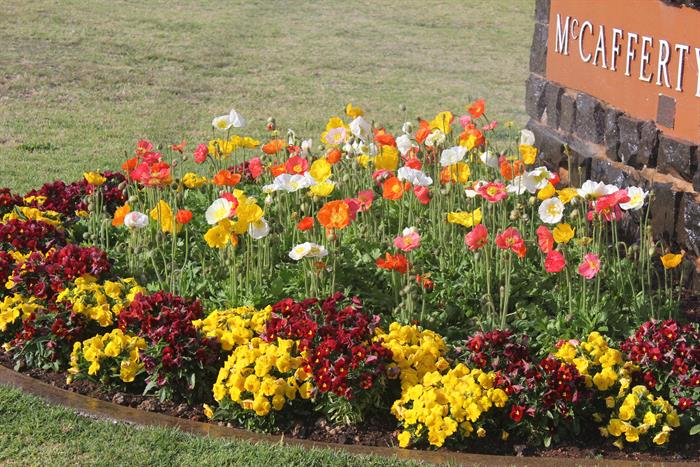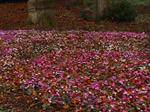Creating A Magnificent Flower Garden
Generous use of flowers in your garden can set your garden ablaze with a rainbow of colour, but for the best effect this must be well planned.

Get your Choice of Colours Right
- Avoid colours that clash. Examples include blue with orange, and mauves with yellow.
- Decide on a colour scheme and stick with it. This might be single colour themes, hot colours (such as yellows, oranges & reds), cold colours (such as blues, pinks, and whites), shades of the same primary colour, or one, two or 3 primary colours.
- Your colours must also fit in with surrounding colours. An example is not using hot colours such as reds and yellows, with a house whose exterior is painted pale blue.
 Get Your Timing Right
Get Your Timing Right
- Do you want the same colour all year, or a sequence of changes. For example a garden can be mainly yellow in one season; then become mainly blue, then green, then red, etc.). You might choose plants that flower all at the one time to create a massed display, or you might plan for a progression, as some plants finish flowering, others commence.
- Some flowers last for extended periods. Others flower for short periods only then disappear. Greater care must be taken in timing for the short flowering types.
- You might want to have your flowers in full bloom for a particular time, because of a special function, such as a wedding, Christmas party, or birthday. Knowing how long particular plants take to flower from planting (for quick growing plants such as bulbs and annuals), and when the peak flowering time is for perennial plants can allow you to plan which plants you want in your garden, and when to plant (bulbs & annuals).
Choose Compatible Plants
- Group plants with similar requirements (such as watering, fertilising, light) together.
- Group plants together according to how vigorously they grow, otherwise some plants may overgrow other adjacent ones.
- Be careful that the cultural requirements of some don’t interfere with the growth of others (for example, if you need to dig up bulbs, you can disturb the roots of other plants).
What Types Of Plants To Grow?
Annuals – They are a great way to provide masses of quick colour. They can be readily replaced with a new crop as soon as they have finished flowering. They are generally inexpensive to buy, both as packets of seeds or punnets of seedlings. They can be used as 'fillers' in beds with slower growing plants. They are easy to grow once established, but are short-lived.
 Bulbs -
Bulbs - They can provide masses of colour. Most can be easily established, and maintained if the right conditions are initially provided. Most only require lifting every 3 to 4 years if desired. Alternatively they can be lifted each year, and new displays created from year to year. For best results buy bulbs that are suited to your climate. They are generally more expensive than annuals to buy.
Herbaceous Perennials – These are non-woody plants that are usually quick growing, often very free flowering, and often flower for extended periods. Many will die down in winter, particularly in cooler climate zones, and re-shoot in spring. Many can be easily lifted and divided while dormant. Some will self-seed freely, filling in any gaps in your garden. This type of plant is commonly found in cottage, and other informal type gardens.
Woody Plants – These are generally much longer lived than the other types, often much larger, and generally costlier to purchase. Many may take several years before first flowering. Some woody plants are prolific flowerers (e.g. roses), and some flower for extended periods. Once planted these plants are generally left in position permanently, or at least semi-permanently.
You might choose to feature one of these above types of plants, or massed displays of various types, or a mixture of several different types.
To crown the whole garden you may wish to use flowering trees. These are best suited the style of the garden and the climate, eg in cold climates and cottage gardens, you may want a Weeping cherry, but in the topics for a Balinese garden you may want a Frangipani.
 Preparing a Suitable Site
Preparing a Suitable Site
Each plant has its own preferred growing conditions’, however, for most commonly grown annuals, bulbs, and herbaceous perennials the following guidelines should prove successful:
- Ensure the soil has been well cultivated, and any weeds thoroughly removed. In clay soils you may need to add gypsum or products like ‘clay-breaker’ to help improve the soil’s structure.
- Add plenty of well-rotted organic matter such as compost. This will help improve such things as soil structure, aeration, water holding capacity and fertility.
- Ensure the bed is well drained. This might require installation of sub-surface drainage, or more commonly the creation of a raised bed.
- Ensure you have a suitable soil pH. Most plants commonly grown for their flowers in Australia will grow successfully in a pH of 6-6.5. Lime can be added to raise pH; or acidifying materials such as peat moss, or sulphur powder to lower pH.
Flower Bed Design
The size and shape of your bed will be controlled by such things as your personal preferences, the space you have available, surrounding features such as trees and buildings, how much work you are prepared to do, and how much money you are prepared to spend in terms of flowers, fertilisers, etc.

There are two common types of flower beds:
- Pure Displays
Full of one type of flower only (e.g. annuals). These are often feature displays in the middle of lawns, or edging a path, wall or water feature. Stars and other complex shapes were common in the past, and are coming back into vogue. Such displays might consist of a single variety of flowers, or might consist of a single genus display consisting of a variety of colours and/or shapes of flowers from the same genus (e.g. petunias, tulips).
- Mixed Displays
This might be a bed consisting of a mixture of different plant types, either mixed together or in separate, but adjacent clusters. It might also involve edging a garden bed containing shrubs or perennials. The border of the shrubbery is changed by planting different displays of colourful flowers, but the backdrop remains the same.
In most displays there will be a progression in height, from low growing plants at the edge of beds, going back to progressively larger ones, with the largest ones in the centre of stand alone beds. Alternatively, at the back of beds that butt up to larger features, such as shrubberies or walls. Individual (dot) plants might be located amongst otherwise pure stands of shorter flowers to create a contrast.
Getting the Most out of your Flower Bed
A simple technique to maximise the number of flower displays you can get each year in your flower bed, is to grow your flowers in pots. You can time the production of these potted flowers so that as one display of flowers in the garden finishes, the plants in the pots are just getting ready to flower.By removing the old spent display and placing the potted plants into the bed (still in their pots) and carefully covering the pots with soil and /or mulch so that the pots can't be seen, you can generate a new display in a very short time.
Flowers in Containers
For those who are restricted in their garden space or for gardeners who have problem soils, potted flowering plants can offer a flexible alternative. They will provide a bright but temporary display, making them ideal for rented flat dwellers. They can be grown in hanging baskets on the veranda, in window boxes, hung on walls or in pots on balconies and in courtyards. The most important things are to make sure the containers receive adequate sun, water (you will need to take special care with pots under eaves the plants will rely entirely on you to give them water) and nutrients (use a liquid feed regularly for best results).
Want to Know More?
Consider doing a course or buying a reference book from our school.
If you would like to communicate with one of our professional tutors, consider using our free course counselling service. click for details
More from ACS
Ebook - 117 pages of wonderful information, stunning pictures and great facts on lavenders.
View eBook
Ebook - Great colourful reference - professionals, home gardeners: all you need to know to grow bulbs for pleasure and profit.
View eBook
Ebook - Colourful informative book: covers all aspects of growing and using these lovely plants.
View eBook
Ebook - A must read for the enthusiast and amateur: 124 pages of bursting colour, covers care as well as identification.
View eBook
Ebook - Identify, select, grow, care, propagate, landscape,
dictionary of perennials.
View eBook
Course - learn how to include range of lovely scented plants in gardens. Create a scented garden.
View Course
Course - for: Nurserymen, Garden Centre Staff, Gardeners, Landscapers, Cut Flower Farmers
Seed Producers, Merchants, Breeders, Hobbyists.
View Course
Course - For the professional Flower Grower or those starting out - covers all the fundamentals plus many flower varieties.
View Course
Course - Learn cottage garden design using heritage plants (or modern, drought tolerant plants plus features eg. formal to semi-formal; designs, arches, arbours, statues, gazebos, picket fencing, etc.
View Course
Ebook - Types: flowers, vegetables, herbs; garden designs, seasonal displays; selection, care, problems, propagation.
View eBook